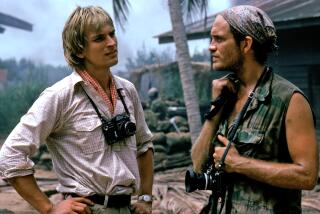Leading by way of example
- Share via
In its own sneaky way, “Stranger Than Paradise” utterly transformed the landscape of American independent cinema. Jim Jarmusch’s 1984 breakthrough belongs with such landmarks of the last quarter century as Steven Soderbergh’s “sex, lies and videotapes,” which inaugurated the beginning of the Sundance boom, and Quentin Tarantino’s “Reservoir Dogs,” which inspired a legion of slavish imitators.
But “Stranger Than Paradise” could be said to have been more pervasive in its influence than any Tarantino film. It invented a sensibility that, for better or worse, has become second nature to successive generations of filmmakers. The movie itself remains too eccentric to have been successfully emulated, but its salient ingredients -- character quirks, low-key incident, gentle irony, self-conscious hipness -- practically add up to a working definition of indie as we know it.
It’s a testament to the singular beauty and strangeness of this hangdog fable, out in a two-disc edition from the Criterion Collection this week, that 23 years after its release, it still feels fresh. The heroine, Eva (Eszter Balint), is an empathetic stranger in Jarmusch’s strange land, a teenager from Budapest who arrives in New York with a beat-up suitcase and Screamin’ Jay Hawkins blaring from her portable tape player. She’s en route to an elderly aunt in Cleveland and crashes for a few days in the run-down apartment of her irritable Hungarian-born cousin Willie né Bela (John Lurie), a fully assimilated fedora-clad hipster who won’t allow Eva to speak Hungarian and barely tolerates her straight-faced inquiries (“Why is it called ‘TV dinner’?”).
One year later, in trouble for cheating at poker, Willie and his friend Eddie (Richard Edson) drive to Ohio (Jarmusch’s home state) in search of Eva. The reunion leads to some desultory hanging out: a night at the movies, card games with Aunt Lotte (a hilarious Cecillia Stark) and a trip to Lake Erie, which appears here as a white, wintry expanse of nothingness. And then, as abruptly as they’d left New York, Willie and Eddie take off for Florida, this time with Eva in tow.
“Stranger Than Paradise” was shot in black-and-white 16 millimeter by director-to-be Tom DiCillo (“Living in Oblivion,” “Delirious”) with a keen eye for desolation and disrepair. Moving from the empty streets of Manhattan’s ungentrified Lower East Side to the suburban sprawl of Cleveland, the movie favors landscapes of urban decay. Even Florida, idealized before the fact as a tropical paradise, is rendered as a patch of scrubby coastline and a cramped motel room.
The film is pure essence of downtown New York circa 1984, in terms of both its sensibility and its personnel (Lurie and Edson were well known in the local music scene). But this time capsule has held up remarkably well, not least for its considerable formal poise. Jarmusch, in his late 20s when he started making the film, turned his budgetary and scheduling constraints into an effective minimalist style. Every scene is a single take. In this most economical of shaggy-dog tales, there are only 67 shots in total, separated from one another by a bit of black screen. The most evocative description of the film’s winning if incongruous tone comes from Jarmusch himself, who in the original press kit characterized it as “a neo-realistic black comedy in the style of an imaginary East European director obsessed with Ozu and ‘The Honeymooners.’ ”
“Stranger Than Paradise” was only Jarmusch’s second film, after 1980’s little-seen Lower East Side reverie “Permanent Vacation,” which is included on the bonus disc. Criterion is also releasing another Jarmusch title this week, the passably comic if somewhat forgettable taxicab omnibus “Night on Earth” (1991), which strings together five encounters between driver and passenger happening on the same night in Los Angeles, New York, Paris, Rome and Helsinki.
More to Read
Only good movies
Get the Indie Focus newsletter, Mark Olsen's weekly guide to the world of cinema.
You may occasionally receive promotional content from the Los Angeles Times.








